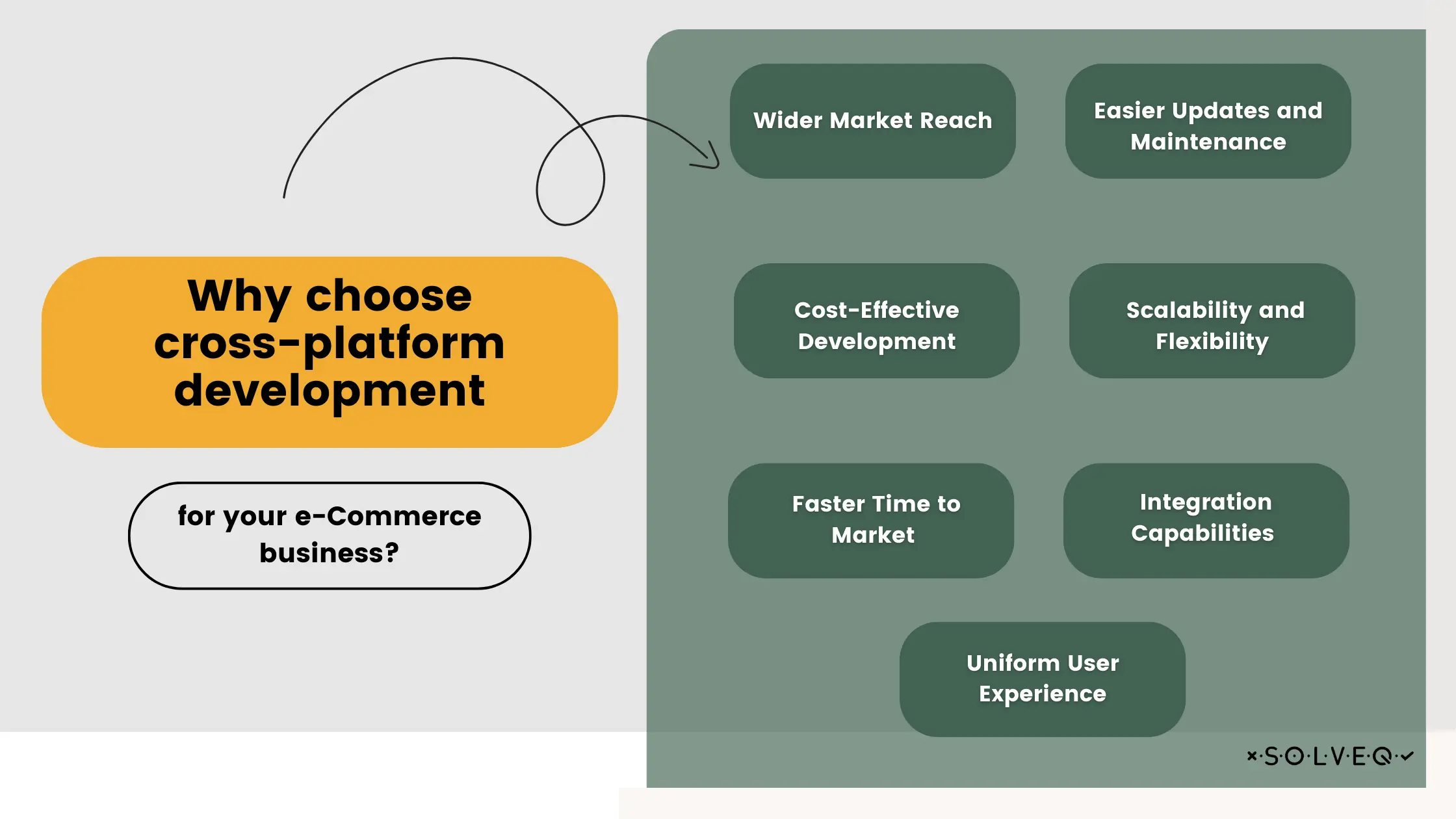Why choose cross-platform development for your e-Commerce business?
1 Feb 2024 • 29 min read

Marcin Kulawik

In today's digital age, cross-platform technology has emerged as a game-changer in the e-commerce landscape. This innovative approach allows businesses to develop applications that seamlessly run across multiple devices and operating systems, expanding their reach and optimizing user experiences. As the e-commerce sector continues to evolve, understanding the power of cross-platform development is essential for businesses looking to thrive in the competitive online marketplace. Join us as we delve into the world of cross-platform technology, explore its advantages and real-world applications, and discover how this knowledge can propel your e-commerce endeavors to new heights.
Wider Market Reach
Cross-platform development is crucial for e-commerce businesses aiming to reach both Android and iOS users. With the market almost evenly divided between these two platforms, a cross-platform approach ensures that no potential customer is overlooked. This strategy is vital for tapping into the full spectrum of the smartphone user market, where accessibility can significantly influence consumer choices and shopping behaviour.
Real-World Statistics and Market Reach
Real-world data highlights the expansive potential of cross-platform development. As of 2022, there were approximately 6.6 billion smartphone users globally, constituting 83.32% of all smartphone subscriptions. This vast user base underscores the expansive reach e-commerce applications can achieve through cross-platform accessibility. Moreover, the sheer volume of app downloads across platforms is indicative of this potential. In 2022, the Google Play Store saw 110.1 billion downloads, while iOS recorded 32.6 billion app downloads. This distribution across both major platforms reinforces the need for e-commerce businesses to engage both Android and iOS users effectively through cross-platform solutions.
Case Study: Shopify's Success with Cross-Platform Development
Shopify's implementation of cross-platform solutions illustrates the tangible benefits of this approach. By making their e-commerce platform accessible and efficient on both Android and iOS devices, Shopify saw a marked increase in user engagement and sales. This strategy not only expanded their customer base but also reinforced their position as a versatile and user-friendly e-commerce platform.

Uniformity in User Experience
Ensuring a consistent and high-quality user experience across different devices is a key advantage of cross-platform development. This uniformity is crucial for maintaining brand identity and customer satisfaction. A consistent and familiar interface across various platforms can significantly enhance user retention and loyalty, which are vital factors for long-term success in the competitive e-commerce landscape.
Cost-Effective Development
In the competitive landscape of e-commerce, managing development costs while achieving maximum efficiency is crucial. Cross-platform development emerges as a cost-effective solution, offering significant savings over native development for individual platforms.
Reduced Development Costs
Unified Codebase: The cornerstone of cost efficiency in cross-platform development lies in its unified codebase. Developers can write a single codebase that runs on multiple platforms, such as iOS and Android. This approach eliminates the need to create separate codebases for each platform, significantly reducing development time and resources.
- Efficient Resource Utilization: Cross-platform development allows for the optimal use of development resources. Instead of requiring separate teams with platform-specific skills, businesses can rely on a single team proficient in cross-platform technologies. This not only streamlines the development process but also cuts down on manpower costs.
- Faster Time to Market: With a unified codebase, the time from development to deployment is substantially reduced. Quicker development cycles mean e-commerce businesses can launch their applications faster, providing a competitive edge in rapidly evolving markets.
Lower Maintenance and Update Costs
- Simplified Updates: Cross-platform applications facilitate easier maintenance and updates. Any changes or updates need to be implemented only once in the shared codebase, automatically reflecting across all platforms. This efficiency drastically lowers ongoing maintenance costs.
- Consistent Performance Across Platforms: By maintaining a single application, businesses can ensure consistent performance and user experience across different platforms. This consistency reduces the likelihood of platform-specific bugs, further lowering maintenance costs.
Cost Comparison with Native Development
- Native Development: Developing native applications for each platform requires separate development efforts, which can double the cost and time. For instance, a business would need distinct teams for iOS and Android, each with specialized skills in the respective platform’s native language (Swift for iOS, Kotlin or Java for Android).
- Cross-Platform Development: In contrast, cross-platform development typically involves languages and frameworks like React Native or Flutter, which are designed to work across multiple platforms. This approach can reduce overall development costs by 30-40% compared to native development, as it requires fewer resources in terms of both manpower and time.
In conclusion, cross-platform development offers a cost-effective approach for e-commerce businesses. By reducing both initial development and ongoing maintenance costs, it allows businesses to allocate resources more efficiently, thereby optimizing their investment and accelerating their growth in the digital marketplace.
Faster Time to Market
In the dynamic world of e-commerce, the ability to quickly adapt and respond to market trends is a key determinant of success. Cross-platform development significantly accelerates the development process, enabling businesses to launch their e-commerce platforms more rapidly than traditional methods allow.

Accelerated Development Process
The speed of cross-platform development lies in its efficient use of resources and streamlined workflow. Key aspects include:
- Simultaneous Development for Multiple Platforms: Cross-platform frameworks enable simultaneous development for both iOS and Android platforms. This parallel development approach is more efficient compared to the sequential process required in native app development, leading to a quicker completion of the final product.
- Reusable Codebase: A major advantage of cross-platform development is the high percentage of code reuse. Developers can write the code once and deploy it across multiple platforms, drastically reducing the time spent on writing and testing platform-specific code.
Benefits of Faster Deployment
Rapid deployment offers several strategic advantages for e-commerce businesses, particularly in a market that values speed and agility. These benefits include:
- Capitalizing on Market Opportunities: In the fast-paced e-commerce sector, market trends can shift rapidly. A faster development cycle means businesses can capitalize on these trends before they pass. Being able to quickly launch a new feature or product in response to market demands can give e-commerce platforms a significant competitive advantage.
- Meeting Customer Needs Promptly: Today's consumers expect quick and continuous improvements in their digital experiences. Cross-platform development allows businesses to update their e-commerce platforms and roll out new features swiftly, keeping pace with customer expectations and enhancing user satisfaction.
- Cost-Effective Marketing and Promotion: With a reduced time to market, e-commerce businesses can plan and execute marketing strategies more effectively. Aligning product launches with specific marketing campaigns or seasonal trends becomes more feasible, potentially leading to higher engagement and sales.
Real-Life Example: H&M's Mobile App Development
A notable example of the benefits of cross-platform development is seen in the case of H&M, the global fashion retailer. H&M utilized cross-platform technologies to revamp their mobile app, enabling rapid deployment across multiple markets. This approach allowed H&M to quickly introduce features like online shopping, in-store stock checks, and personalized recommendations, catering to the diverse needs of their global customer base. The cross-platform strategy not only streamlined their development process but also accelerated their response to market trends and customer preferences, enhancing their competitive edge in the fast-paced fashion industry.
In conclusion, cross-platform development is not just a technical choice, but a strategic business decision. By enabling faster deployment of e-commerce platforms, businesses can stay ahead of the curve, rapidly respond to evolving market dynamics and customer needs, and seize opportunities as they arise in the competitive digital marketplace.
Uniform User Experience
In the realm of e-commerce, the importance of delivering a consistent user experience across various devices is paramount. Cross-platform development is instrumental in achieving this, ensuring uniformity in user experience, which is key to maintaining brand consistency and meeting usability standards.
Consistency Across Devices
Achieving a seamless user interface across different platforms is a fundamental aspect of cross-platform development. This approach includes:
- Seamless User Interface: By utilizing cross-platform development, businesses can design an interface that remains consistent across different devices and platforms. This uniformity is crucial for customers to have a familiar shopping experience, whether on a mobile app, tablet, or desktop.
- Brand Recognition and Trust: Consistency in user experience reinforces brand identity. When the look and feel of the platform are the same on every device, it enhances brand recognition and fosters trust. This aspect is vital for building a loyal customer base in the competitive e-commerce landscape.
Maintaining Usability Standards
Cross-platform technologies are pivotal in maintaining high usability standards across different devices, offering:
- Intuitive User Experiences: These technologies enable the creation of user-friendly interfaces that are intuitive and easy to navigate for all users, which is essential for inclusivity and accessibility in the e-commerce domain.
- Responsive Design: Ensuring that applications are responsive and adapt smoothly to various screen sizes and orientations is a hallmark of cross-platform frameworks. This responsiveness is a critical factor in providing a positive user experience, given the diverse range of devices used for online shopping.
Real-Life Example: Airbnb's Cross-Platform UX
Airbnb's application of cross-platform development offers a clear illustration of uniform user experience done right. By adopting this approach, Airbnb has successfully maintained a consistent and recognizable interface across its web and mobile applications. This consistency not only simplifies navigation for users but also bolsters Airbnb’s brand as a user-centric entity in the hospitality industry, enhancing customer satisfaction and brand loyalty.
In essence, cross-platform development is more than a technological choice; it's a strategic approach for e-commerce businesses aiming to provide a cohesive and satisfying shopping experience. It's instrumental in building and maintaining customer loyalty and a strong brand presence in today's diverse digital marketplace.

Easier Updates and Maintenance
For e-commerce businesses, the ease of updating and maintaining their applications is just as important as the initial development. Cross-platform development significantly streamlines this aspect, making the process more efficient and less resource-intensive.
Streamlined Update Process
The streamlined nature of managing updates in cross-platform applications brings several key advantages:
- Single Update Across All Platforms: One of the most significant benefits of cross-platform development is that updates need to be made only once in the shared codebase. This change is then automatically reflected across all platforms, whether iOS, Android, or web. This unified approach eliminates the need for multiple updates on different platforms, saving time and reducing the likelihood of inconsistencies or errors.
- Consistent Experience with Every Update: Ensuring that every user, regardless of their device, receives the same updates at the same time is crucial for maintaining a uniform user experience. Cross-platform development facilitates this, providing a consistent experience with every update, which is vital for customer satisfaction and trust.
Enhanced Security Management
- Easier Security Updates and Patches: Managing security is a critical aspect of e-commerce. With cross-platform development, applying security updates and patches becomes a more straightforward process. Security enhancements are implemented once in the common codebase and are then automatically applied across all platforms, ensuring that the application remains secure on every device.
- Proactive Response to Vulnerabilities: The ability to quickly and efficiently address security vulnerabilities is crucial in the digital world. Cross-platform solutions enable businesses to respond proactively to security threats, patching vulnerabilities in a timely manner across all platforms, thus safeguarding customer data and maintaining trust.
In summary, cross-platform development not only simplifies the initial creation of e-commerce platforms but also makes their ongoing updates and maintenance more manageable. This ease of updating and maintaining applications ensures that businesses can keep their platforms secure, up-to-date, and aligned with customer needs, without the extra overhead associated with managing multiple versions of the same app.
Scalability and Flexibility
In the ever-evolving landscape of e-commerce, the ability to scale and adapt is vital for businesses. Cross-platform development provides an inherently scalable and flexible solution, making it easier for e-commerce platforms to evolve in response to changing business needs and market demands.
Adaptable to Business Growth
Cross-platform solutions are designed with scalability in mind, offering several key benefits:
- Ease of Feature Integration: As businesses grow, their e-commerce platforms often need to incorporate additional features or functionalities. Cross-platform frameworks are well-suited for this, allowing for easy integration of new features without the need to overhaul the entire application.
- Responsive to Market Changes: The flexibility of cross-platform development means businesses can quickly modify their e-commerce platforms in response to market trends or consumer demands. This agility is a significant advantage in a competitive market where speed and responsiveness are crucial.
Efficient Resource Allocation
- Optimized Development Resources: Scaling an e-commerce platform typically requires additional development resources. Cross-platform development, with its shared codebase, allows businesses to optimize resource allocation, reducing the need for platform-specific development teams.
- Cost-Effective Expansion: Expanding an e-commerce platform's reach or capabilities often involves significant investment. However, with cross-platform solutions, businesses can scale more cost-effectively, as the same codebase and development effort serve multiple platforms.
Real-Life Example: Alibaba's Expansion with Cross-Platform Technology
A prime example of successful scalability using cross-platform development is Alibaba, one of the world's largest e-commerce platforms. Alibaba leveraged cross-platform technology to expand its operations, introducing new features and adapting to different market segments efficiently. This approach allowed Alibaba to scale its user base and offerings rapidly, meeting the diverse needs of a global audience and maintaining its position as a market leader.
In conclusion, the scalability and flexibility offered by cross-platform development are invaluable for e-commerce businesses. This approach not only facilitates growth and adaptation to changing market conditions but also ensures efficient and cost-effective expansion. As demonstrated by successful companies like Alibaba, cross-platform solutions are key to scaling e-commerce operations effectively in today's dynamic digital marketplace.
Integration Capabilities
A key strength of cross-platform e-commerce platforms lies in their robust integration capabilities. The ease of integrating various APIs, payment gateways, and other essential tools is a significant advantage, enabling a more seamless and functional e-commerce experience.
Simplified Integration with Diverse APIs
- Unified Approach to API Integration: Cross-platform development allows for a streamlined approach to integrating a wide range of APIs. Whether it's a social media API for enhanced customer engagement or a logistics API for shipping and tracking, cross-platform applications can interact seamlessly with these services across all platforms. This unified approach simplifies the development process and ensures consistent functionality.
- Flexibility in Payment Gateway Integration: The ability to integrate various payment gateways is crucial for any e-commerce platform. Cross-platform development frameworks offer the flexibility to incorporate multiple payment options, from traditional credit card processors to modern digital wallets. This versatility is essential in providing a convenient and secure shopping experience for customers.
Enhanced Functionalities and User Experience
- Rich E-commerce Features: The integration capabilities of cross-platform solutions allow for the inclusion of advanced e-commerce features like personalized recommendations, real-time inventory management, and customer analytics. These integrations enhance the functionality of the platform, leading to a richer user experience.
- Consistent Experience Across All Devices: With cross-platform development, the integrations work uniformly across different devices and operating systems. This consistency ensures that customers have a seamless experience, whether they are accessing the e-commerce platform on a smartphone, tablet, or desktop.

Real-World Example: Amazon's Cross-Platform Integrations
Amazon, a global leader in e-commerce, exemplifies the successful implementation of cross-platform integration capabilities. By utilizing cross-platform technologies, Amazon has integrated a variety of payment options, customer service tools, and third-party APIs into its platform. This approach has enabled Amazon to offer a seamless shopping experience across all devices, contributing to its reputation as a user-friendly and reliable e-commerce site.
In conclusion, the integration capabilities of cross-platform development are pivotal in creating a seamless and functional e-commerce experience. This approach not only simplifies the integration process but also ensures that e-commerce platforms can offer a wide range of features and services, enhancing the overall customer journey and satisfaction.
Challenges and Considerations
While cross-platform development offers numerous advantages for e-commerce businesses, it's essential to be aware of the challenges and considerations that come with this approach. Addressing these challenges and making informed decisions is key to a successful implementation.
Performance Challenges
Managing performance challenges in cross-platform development is crucial for delivering a seamless user experience:
- Potential Performance Bottlenecks: Cross-platform applications may face performance challenges, especially when compared to native apps. This can be due to the additional layer of abstraction introduced by cross-platform frameworks. It's crucial to carefully assess performance requirements and ensure that the chosen framework can meet them.
- Optimization and Testing: To mitigate performance issues, developers must focus on optimization and thorough testing. This includes optimizing code, reducing unnecessary operations, and ensuring that the app functions smoothly across different devices and platforms.
Choosing the Right Framework
Selecting the appropriate framework is a critical decision that significantly impacts the success of your cross-platform project:
- Framework Selection: One of the most critical decisions in cross-platform development is choosing the right framework. Each framework has its strengths and weaknesses, and it's essential to select one that aligns with your project's requirements. Consider factors like community support, the ability to access native features, and long-term maintenance.
- Hybrid vs. Native Look and Feel: Cross-platform apps often strike a balance between a native and web-based experience. Businesses must decide whether a hybrid look and feel are acceptable for their users or if they require a more native-like experience.
Mitigating Challenges
Effectively addressing challenges is vital for the success of your cross-platform e-commerce project:
- Performance Profiling: Regular performance profiling is essential to identify and address performance bottlenecks. Developers should use profiling tools to pinpoint areas that need improvement and optimize code accordingly.
- Platform-Specific Code: In some cases, it may be necessary to write platform-specific code to achieve optimal performance or access specific features. A well-thought-out architecture that allows for the inclusion of native code when needed can be beneficial.
- User Experience Testing: Continuously testing the user experience on different devices and platforms is vital. This ensures that the app remains functional and user-friendly for all users.
Real-Life Example: WhatsApp's Journey
WhatsApp initially adopted a cross-platform approach using a technology called WebView. However, they encountered performance issues, especially on older devices. To address these challenges, WhatsApp eventually transitioned to a more native approach, effectively mitigating the performance issues and improving the overall user experience. This real-world example illustrates the importance of adapting the development approach as challenges arise.
In conclusion, while cross-platform development offers compelling advantages for e-commerce, it's essential to be aware of potential challenges and considerations. Addressing performance issues, choosing the right framework, and implementing best practices for mitigation are crucial steps in ensuring a successful cross-platform e-commerce application.
Success Stories
When tring to explain the impact the reasons to include cross-platform development into your e-commmerce business its best to show real-life examples. He can highlight and express the facts and recommendations presented above and are a great way to visualise discussed solutions. Here are a few of them:
Ad Hoc Atelier
An Italian e-commerce platform specializing in exclusive clothing and accessories, Ad Hoc Atelier, illustrates the effectiveness of integrating advanced digital tools into e-commerce. By incorporating live chat functionalities, the platform significantly improved customer engagement. This strategic implementation led to a substantial increase in their conversion rate from 0.35% to 0.9%, and a decrease in the cart abandonment rate from 83% to 73%. The reduction in average response time from 3 hours to just 1 minute exemplifies how cross-platform technologies can enhance the customer experience and drive sales.
Dollar Shave Club
Dollar Shave Club's journey in the e-commerce landscape serves as a prime example of leveraging a unique value proposition and a subscription-based model. Founded in 2011, they disrupted the men's grooming product market by offering high-quality razors at an affordable price, conveniently delivered to customers' doors. Their success story underscores the importance of a well-crafted marketing strategy and the utilization of data analytics in optimizing marketing efforts. Dollar Shave Club's approach demonstrates how a focused digital strategy can effectively build brand awareness and customer loyalty in the e-commerce sector.
Prominent Educational Material Retailer in the USA
This retailer's move to cross-platform development epitomizes the impact of strategic technological adaptation in e-commerce. Faced with declining sales and the need for more efficient automation, they developed a mobile application using React Native, which catered to the growing user demands for mobile accessibility. This shift not only led to a 15% increase in online sales but also a 20% reduction in marketing costs. The case of this retailer highlights how cross-platform development can significantly boost operational efficiency and market responsiveness, thereby enhancing both customer engagement and business profitability.
Summary
Cross-platform technology is revolutionizing e-commerce, enabling seamless app experiences across devices. It expands market reach, reduces costs, and accelerates time to market. With scalability and flexibility, businesses can adapt and grow, while robust integration capabilities enhance functionality. Embrace cross-platform development for success in the dynamic digital marketplace.
Ready to harness the power of cross-platform development? Contact us for tailored solutions.
Share:
Looking for expert development team?
Schedule a call with Tech Consultant

Marcin Kulawik
Founder and CEO of SolveQ. Huge fan of building things with purpose, agility, and having fun while changing the World. Loves his family, teammates, and nature.